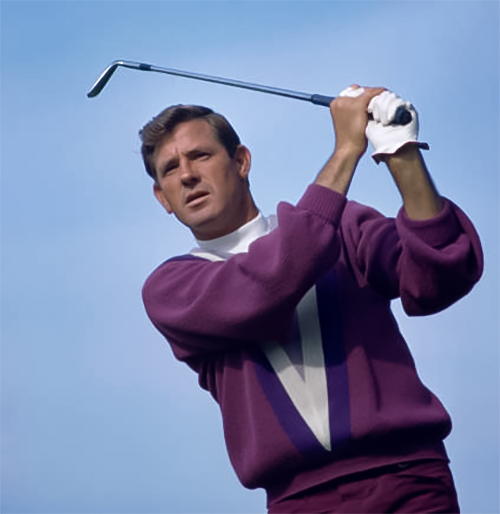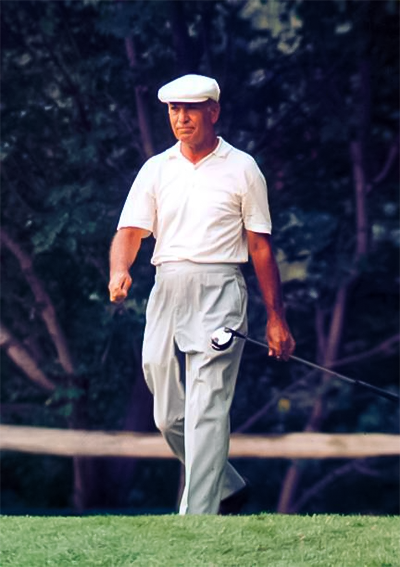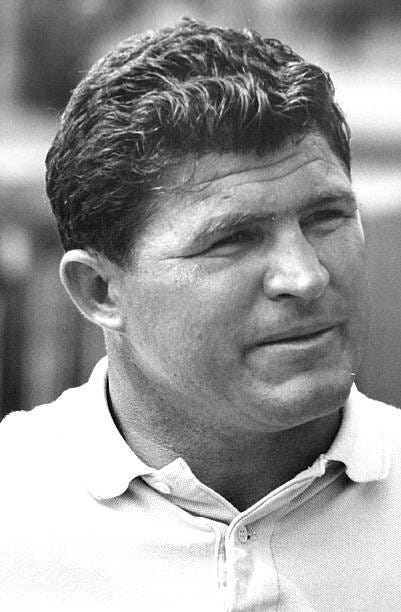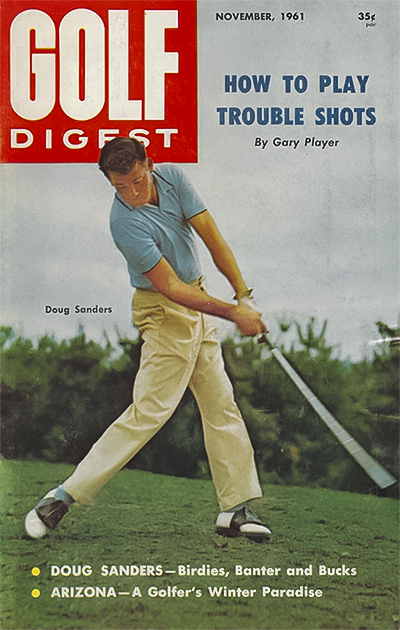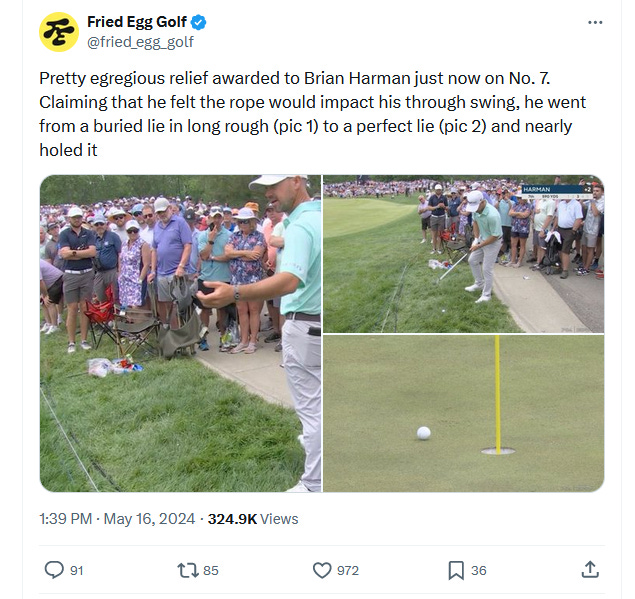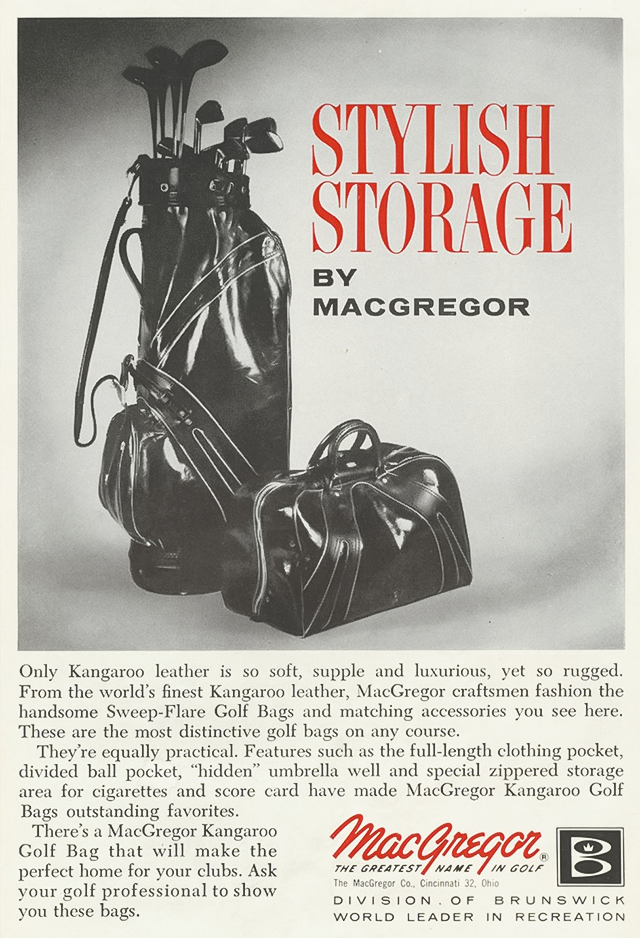Largest Comeback at Colonial Since Hogan in 1946
Doug Sanders stages comeback in final round of the 1961 Colonial National Invitational
What a week in Louisville at the PGA Championship. A very eventful week with the Scottie Scheffler story, a first-time major winner in Xander Schauffle, and an image reboot for Bryson DeChambeau.
This week, our journey through the past takes us back to 1961 and the Colonial National Invitational, also known as the NIT. Colonial Country Club hosted this prestigious, and lucrative tournament that Ben Hogan won five times, including the first time the event was held in 1946. He also defended his title winning in 1947. The tournament honors the history of golf by awarding the winner an official Scottish tartan plaid jacket. Scroll down to see how Doug Sanders beat a stacked field and then whisked his wife off to Acapulco to celebrate.
We wrote about the 1967 Colonial when Dave Stockton turned a Champion’s Invite into a victory, and the 1971 event won by Gene Littler.
The week in Louisville for the PGA was quite the tournament. Congratulations to Xander Schauffle for winning his first major championship. We’ve got a lot for you from the week, so scroll down for the Clips You Might Have Missed, a few thoughts on the week from me, a recap of the tournament and highlights.
We want to hear from you in the Tour Backspin Poll, and this week’s Music Clip goes back to 1961 and a live performance by Del Shannon. We’ve got the short and unique swing of Doug Sanders in this week’s Swing Like a Pro and we bring you another tip from Tony Lema. Last week’s WHAT HOLE IS IT? was pretty easy and were keeping those vibes going this week, so let us know your answer and you may just win a golf swag prize pack. We’ve got some links for you in the Check it Out section and a Vintage Ad from 1961 featuring gorgeous leather goods from MacGregor . Scroll down to view.
We understand if you can’t pay for a premium subscription and we’re happy to have you here however you’ve arrived. You can sign up for a free subscription so you’ll never miss the newsletter. It will arrive in your inbox every Thursday.
In last week’s Tour Backspin Poll we asked if the winning score in the PGA Championship would be over or under 14.5. The players blew that number out of the water so the 89% of respondents who said over knew what they were talking about.
How do you think the PGA broadcast went? Did ESPN do a good job? How about CBS? Let us know in this week’s Tour Backspin Poll.
Tour Backspin Poll
Do you know what happened today in golf history? Or which famous golfer has a birthday today? Me, neither. But I do know where to go to find out. Check out the Your Golfer’s Almanac podcast. Host Michael Duranko celebrates birthdays, milestones, and other accomplishments that occurred on this day in golf history. Listen HERE.
We’re playing I Fought the Law Trivia in this week’s Tour Backspin Quiz. Scroll down to play.
Did you miss a previous newsletter? You can view it HERE. Help us grow Tour Backspin! Please forward this email to a friend. Was this newsletter forwarded to you? You can sign up HERE.
Okay, we're on the tee, let's get going.
Enjoy!
Larry Baush
Doug Sanders Wins at Colonial, Celebrates in Acapulco
It is Tuesday, May 9th, 1961, and Lloyd Mangrum is talking with Jim Trinkle, the Fort Worth Star-Telegram sportswriter, about his trip to the Colonial National Invitational (NIT) being held at Colonial Country Club in Fort Worth, Texas. Mangrum flew his own plane from his home in Apple Valley, CA, to Fort Worth, the same as he had done for the last few years. And each year, Mangrum renewed acquaintances with the men on the ground operating the radio check stations on his route.
“It’s a real nice experience after I pass El Paso,” Mangrum told Trinkle. “I just have two stations to call—Wink and Abilene. But I always talk to the guys at Midland, too. I’ll give them the number of my plane and they always want to know who the pilot is. When I tell them they say, ‘Going to the Colonial?’ or ‘Is that you Lloyd?’”
Mangrum was comfortable coming to Fort Worth where he was going to be playing in his 14th Colonial National Invitational.
“The course is in the best condition it has ever been at this time of year.”
“Then I’ve been staying at the same hotel 10 years, I guess,” Mangrum said. “So all the bellboys, maids and waitresses call me by my name. It’s real nice.”
The players were effusive in their praise of the conditions at Colonial that played to a par of 70. Ben Hogan said, “The course is in the best condition it has ever been at this time of year.”
There were 57 players who were invited to the National Invitational, 534 professionals and three amateurs: reigning U.S. Amateur champion, Deane Beman, Charlie Coe, who finished as low amateur, in a tie for second with Arnold Palmer behind the winner Gary Player, at the Masters back in April, and Jack Nicklaus, who finished second in the 1960 U.S. Open.
This would be the largest field in National Invitational history, and it was a tournament that the players loved. For one thing, anybody making the cut and finishing four rounds was rewarded with a check of $100 in an era where making the cut and not winning any money was a weekly occurrence. It was also one of the richer tournaments on the schedule with a purse of $40,000.
On Wednesday, in the first ever pro-am to proceed the NIT, Doug Ford shot a 64, a new competitive course record, to take individual honors beating Al Geiberger and Bill Collins by one-stroke. Don January scored an ace at the 197-yard, 16th hole, using a 4-iron. It was the only ace in the history of the tournament, but it was January’s second ace in three months.

There was birthday cake to pass around at the pro-am as Mike Souchak celebrated his 34th birthday.
Arnold Palmer arrived at Colonial on Wednesday after finishing second-to-last in the Tournament of Champions in Las Vegas the week before. He did not play in the pro-am, but he was ready for Colonial after re-gripping his clubs, going back to the leather grips he liked.
“I tried these other kind in Las Vegas, and it just didn’t work. My hands were sore all the time. Of course, I may have had too much right hand in my swing out there too,” he joked to reporters as he made a dice-throwing motion with his hand.
Ben Hogan was making one of his rare appearances on tour at a place that he always played well and had won the event five times, was also not playing in the pro-am, as well as Dow Finsterwald. The amateurs Jack Nicklaus, Deane Beman, and Charlie Coe captained teams in the pre-tournament event filling in for the three missing pros.
The sky was clear and blue with temperatures reaching the high 70s during Thursday’s first round. The three amateurs, Beman, Nicklaus, and Coe, played together teeing off at 11:10, the second group of the day. Beman needed only 29 putts on his way to a 68 and the early lead. Byron Nelson hit the first shot of the day teeing off at 11:00.
The Australian, Kel Nagle, teed off at 1:00 playing with Ben Hogan and Julius Boros. So far, 1961 had been a disappointment for Nagle as he came into Colonial with just $1,165 in earnings. In the Waco Turner Open, an alternate event played opposite the Tournament of Champions, Nagle missed the cut, but in the first round of the NIT, he found some magic.
Nagle birdied the first two holes and made the turn with a 2-under-par 33. He saved par from bunkers on both the 10th and 12th holes before coming to the 195-yard, par-3, 13th hole which requires a carry over the Trinity River. Nagle hit a 2-iron that hit on the front of the green, bounced twice, and then hopped into the hole for an ace.
“Good shot,” Hogan dryly commented with a grin on his face.
With the aid of the ace, and a birdie at the final hole, Nagle finished the back nine 3-under par for a total of 65, matching the tournament single round record, and a three-stroke lead over Beman, and Arnold Palmer. Another stroke back was Doug Sanders, Billy Casper, and Mike Souchak.
“It was on the flag all the way,” Nagle said of his hole-in-one. “This is my kind of course. It’s a lot like the type we have in Australia.”
Attendance was estimated to be 10,000 fans for the first round.
Winds reaching gusts of 30 miles-per-hour swirled over the Colonial Country Club layout during Friday’s second round making for difficult playing conditions. Nagle blew to 76, as did Sanders, who bogeyed the last three holes. Beman soared to a 79.
Souchak was able to match par and his 70, giving him a two-day total of 139 and a two-shot cushion over Nagle, Palmer, who had a second-round 73, and Casper who had a 72. Hogan’s putter betrayed him as he carded a 75 for a total of 143, one shot behind Ernie Vossler (71-71), Gene Littler (72-70), and Doug Ford (71-71).
Attendance was estimated at 11,000 spectators breaking the Colonial attendance record for the second straight day.
“I chipped to within about 14-feet, and then three-putted.”
Milder winds and easier pin positions greeted the players on Saturday for the third round and the players took advantage of the conditions. Except for Mike Souchak who despite an eagle three on the first hole, ran into difficulties starting at the par 3, 4th hole, where he had a triple bogey. His tee shot came to rest next to a boundary fence post and he had to hit a putter left-handed just to advance the ball.
“I chipped to within about 14-feet,” Souchak explained after his round, “and then three-putted.”
Palmer, playing with Souchak, took over the lead with his second birdie on the same hole. Souchak stumbled again on the 6th and 8th holes with bogeys and when the group that also included Gene Littler made the turn to start the back nine, Palmer led Souchak by three and Littler by one shot.
Just to make things exciting, Casper was just two off Palmer’s lead and Sanders was making a move making birdies. Littler’s putter was getting hot, and he birdied both the 10th and 11th holes, taking over the solo lead. Palmer bogeyed the 12th hole and Casper then bogeyed the 13th hole and double bogeyed the 14th hole.
Littler now had a three-stroke lead but then he bogeyed the 14th hole after hitting his approach into a bunker. He followed with a bogey on 16 after missing a short putt and his lead was now only one-stroke over Palmer. Casper put himself back into contention with a birdie on the 17th hole.
“I was putting better than I have for a year, and that was the difference today.”
Sanders kept his steady pace and finished with a 67 for a three-round total of 211 and the clubhouse lead. Casper was able to get to the clubhouse with a third-round 69 for a total of 210. Palmer also shot a 69 and was at 210, while Littler came in with a 67 and was at 209.
“I was putting better than I have for a year, and that was the difference today,” Littler said after his round.
Sanders explained his round to Frank Luksa of the Fort Worth Star-Telegram saying, “I drove real well, hit good iron shots, and just played a steady game.”
The Canadian pro, Stan Leonard drove the ball “just super” helping him to card a 68 and a total of 212 and would play on Sunday in the final group with Littler and Palmer.
“I had an easy round but if my putter had been working, I’d really been in business,” Leonard told Luksa.
Gardner Dickinson was also at 212 and would be playing in the penultimate group along with Sanders and Casper. Kel Nagle added a third-round 74 and was at 215, while Don Whitt was well placed at 214 after a third-round 69. Hogan was tied with Nagle at 215 after he shot a third-round 72.
Attendance again broke a Colonial record with an estimated 13,500 fans flocking to the course to catch the action. More large crowds, paying a $5 admission, were expected for Sunday’s final round.
It was not easy for the players in the last two groups to keep track of each other during Sunday’s final round. Of the six players, only Dickinson was able to make a birdie on the front nine. Meanwhile, Nagle, playing with Whitt three groups behind the leaders, started his round with two birdies and put himself into the hunt. He finished the front nine with a 34, one-under par.
Littler, Palmer, Leonard, and Casper all could do no better than two-over-par 37 on the front nine while Sanders made the turn in 36. Even so, Nagle did not garner much attention from the fans who were following Palmer, Leonard, and Littler.
Sanders put a draw on his drive off the 10th tee and wound up on the left side of the fairway. He was partially blocked out and would need to hit another draw to put his approach shot close. He considered the shot he hit to be one of the two best shots of his round. He drew a 6-iron around the trees winding up three feet from the hole and then sank the birdie putt.
Meanwhile, behind Sanders, Littler topped his tee shot into the water fronting the 10th and eventually wound up with a double-bogey. Sanders received the news of Littler’s catastrophe on the 11th green and then ran in his four-foot putt for birdie. Littler never again threatened the lead.
“Honey, if I can get that little ol’ ball down in two, we’re going to Acapulco.”
Nagle birdied the 11th and 16th holes and was able to post a 67 for a total of 282 and could only sit back and see how Sanders finished. Sanders made it interesting when he bogeyed the 17th hole requiring him to par the final hole to beat Nagle.
Sanders hit his approach shot at the 18th hole to a comfortable 20-feet and as he and his wife, Joan, walked down the fairway towards the green, he made a promise.
“Honey, if I can get that little ol’ ball down in two, we’re going to Acapulco.”
He did, and they did.
It was the second win of the year for Sanders who won the Greater New Orleans Open earlier in the year. Nagle finished runner-up, for the second time in a row at the NIT as he finished behind Julius Boros in 1960. Casper’s final round 73 put him in third place at 282 while Whitt finished strongly with a 70 and was at 284, tied with Littler who had a final round 75. Palmer also had a final round 75 and was another stroke back at 285. Leonard shot a final round 75 for a total of 287, tied with Doug Ford. Dickinson and Hogan both finished well down the leader board after both shot 76 in the final round. Both Beman and Coe wound up with low amateur honors with a total of 293, while Nicklaus shot 297.
Sanders’ win marked the first time since Ben Hogan’s inaugural victory in 1946 that a winner had come from as far back as fourth after 54 holes. And it was the colorful 27-year-old player from Georgia who was able to do it on the back nine Sunday. Sanders won $7,000 (and the red plaid jacket) for the victory bringing his yearly winnings up to $28,996. Now, he and his wife were going to spread some of that cash around in Acapulco.
Follow us on Facebook, Instagram, Twitter, YouTube and Threads.
BONUS STORY
The crowd Sunday at the Colonial National Invitational was estimated to be 14,000, the fourth straight record crowd. The total attendance, including for Wednesday’s pro-am was 51,500 and brought in $110,921 in ticket sales.
What Hole is It? powered by Rota Golf. Doesn’t your bucket list journey deserve one of these?
WHAT HOLE IS IT?
Are you on the leader board?
Congratulations to everybody who correctly identified #13 at Valhalla Golf Club in Louisville, KT, in last week’s WHAT HOLE IS IT? contest. All 11 of you with the correct answer will be receiving a prize pack. Submit your answer for this week and get yourself into the race for the Herbert C. Leeds Trophy, our new perpetual trophy for the annual winner.
PGA TOUR Wrap-Up | PGA Championship

Whenever you have a birdie putt at the final hole that wins a major tournament, you know you got a good one. The week at Valhalla in Louisville was compelling with many different story lines, on and off the golf course including the tragic death of a tournament volunteer that led to the traffic jam and the whole Scottie Scheffler incident.
On the course, Xander Schauffele won his first major tournament by burying a birdie putt at the final hole. His second shot on the par-5 hole was as, if not more, important as the birdie putt as he had to stand in a fairway bunker with the ball well above his feet.
Viktor Hovland and Bryson DeChambeau challenged Schauffele down the stretch, but Schauffele was able to turn them both back. For Hovland, it was disappointing, but as he admitted in an interview, he almost withdrew from the event before the start because of his play recently.
DeChambeau not only accomplished a second-place finish by shooting a Sunday 64, he also achieved a massive image makeover becoming a fan favorite.
It was quite the week, one that is expected when the best players all play together in a major event on a golf course that has always provided exciting golf.
Read the tournament recap by Adam Schupak of Golfweek USA Today HERE.
Clips You Might Have Missed
Nice recovery from the water.
Another generous drop ruling.
Who doesn’t love Johnson Wagner?
Justin Rose and Shane Lowry had quite the day.
Not a happy camper.
This shot dispersion chart is unreal.
Tour Backspin Quiz | I Fought The Law Trivia
Scottie Sheffler was not the first big name PGA TOUR player to be arrested at a PGA Championship. Who got served with a warrant at the 1963 PGA Championship played at the Dallas Athletic Club?
Scroll down for answer
Swing Like a Pro
They said he could hit it out of a phone booth. Doug Sanders’ golf swing.
Tip From Tony Lema*
Audio excerpts from the book Champagne Tony’s Golf Tips by Tony Lema with Bud Harvey.
(Click on player and scroll down when page opens)
In passing, let me suggest also that you know the rules. Bear in mind that the rules offer you relief from certain unnatural hazards as occasional water and ground under repair, random pieces of maintenance equipment and assorted pieces of flotsam and jetsam that don't belong on any properly supervised golf course. You may lift without penalty from these situations and you owe it to yourself and your game to understand these circumstances.
*AI generated voice
Tour Backspin is a reader-supported publication. To receive new posts and support my work, consider becoming a free or paid subscriber.
Blind Shot
Click for something fun. 👀
Geoff Shackelford on The Cutmakers at the PGA Championship in his Quadrilateral Substack.
Tour Backspin Music Clip
Great sound on this Del Shannon “Runaway” performance from 1961.
Uncorked, The Life and Times of Champagne Tony Lema tells the story of one of the tour’s biggest stars in the mid-1960s. A fascinating glimpse into the traveling caravan that was the PGA TOUR during an era where the fields were full of “Mad Men” era personalities. From a hardscrabble youth spent on the “wrong side of the tracks” in the Oakland suburb of San Leandro, to the temptations of Elko, Nevada, to the bright lights of the PGA TOUR, Uncorked tells a story of determination, redemption and, above all else, a love story that documents how Betty, Tony’s new wife, provided the direction and motivation for him to become a top star. Order on Amazon.
WHAT IS HIP?
Dinner jackets and cozy sweaters were what was hip in 1961 (Photos: Golf Digest / Image: Tour Backspin)
Tour Backspin Quiz Answer:
After completing the fourth round of the PGA Championship at Dallas Athletic Club in 1963, Tony Lema was met by a police officer who served him with a warrant for his arrest. Back in 1961, Lema received a speeding ticket in Dallas and made a court appearance where he was fined $1 for the traffic offense and $15 for court fees.
“I paid the dollar, but refused to pay the court costs because they were so exorbitant,” Lema explained to reporters on site. “Now, I have to go with the officer and pay an extra $100 penalty.”
—From Uncorked, The Life and Times of Champagne Tony Lema available on Amazon.
Thank you for reading this far, I know your time is valuable and choosing to spend some of it on what I’ve created is gratifying. If you want to help support the work we’re doing, please consider upgrading. It’s just $36 a year and you’ll be helping to tell the stories from one of golf’s golden ages.
Vintage Ad
Final Thoughts
Why did that guy keep his socks on in the Blind Shot?
Doug Sanders sure had a unique swing.
I’ll bet you’ve been in Johnson Wagner’s shoes with the chip yips, but not on national television.






